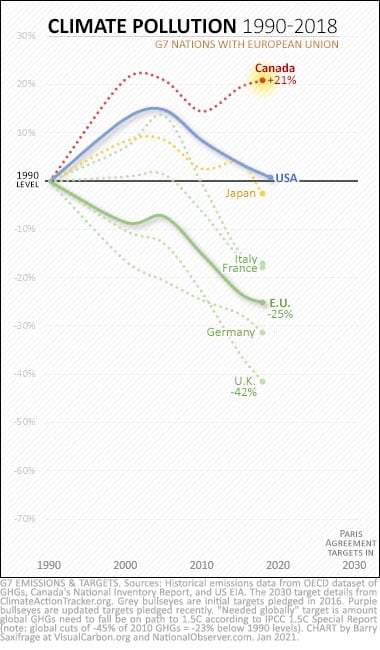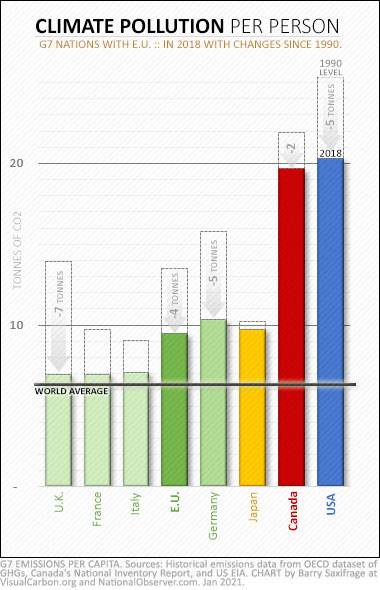To provide an overview of the current situation and the choices ahead, I've created a series of charts covering the G7 plus the European Union. The first charts set the stage by showing you where Canada and its G7 peers are now with their climate emissions and targets. And then I'll add to the chart the new targets announced so far, plus a marker showing what the best climate science says is needed by 2030.
Past emissions
To see where each country is positioned today, let's look at past emissions.
My first chart shows the changes in climate pollution since 1990, the international baseline year for comparing emissions. Most lines end with 2018 because that's the most recent data available from those countries. The U.S. line ends in 2019.

As this first chart makes clear, Canada has been the rouge climate polluter in the group so far.
Despite promising since 1988 to reduce our oversized climate pollution, we've instead cranked it up.
We now find ourselves the only G7 member still polluting well above the 1990 starting line.
And take a look at the lines over the most recent decade — the years when the climate crisis started to hit with increasing fury. Every country lowered emissions over those 10 years except Canada. Ours went up. Our failure to keep pace has left us in a tough position.
The next poorest performers since 1990 have been the United States and Japan. Both emit roughly the same now as they did three decades ago.
The Europeans, in contrast, have reduced their emissions. The 27 countries of the European Union, as a whole, now emit one quarter less than they did in 1990. And our commonwealth peer, the U.K. — aided by its innovative and effective 2008 Carbon Budget law — has managed to cut its climate pollution by more than 40 per cent.
If the British can do it, Canadians can, too. What these European efforts highlight is that Canada's past climate failure has been a choice we've been making. Going forward, we can choose to be a climate leader instead.
Now that we've seen where each country has positioned itself, let's look at where they've pledged to go in the future.
Paris climate targets — Round 1
As noted above, every major economy pledged an initial climate target five years ago as part of the global Paris Agreement.
I've updated my chart to mark initial targets with dark grey bull's-eyes. Germany, France, Italy and the other 24 countries of the European Union all share its single target.

As you can see, Canada and Japan pledged the weakest initial targets. They each promised only a 15 per cent reduction after 40 years.
The Americans pledged a similar tiny reduction, but promised to get there five years sooner, by 2025.
The European Union pledged 40 per cent below 1990. The U.K. targeted a 57 per cent reduction. And the British went the next step and legally bound its government to meet that.
It's worth pausing to note that achieving the European target of a 40 per cent reduction over 40 years only requires cutting pollution by one per cent each year.
It turns out that this is the same reduction rate Canada has been repeatedly promising over the last 30 years. For example, in 1988, the Mulroney government pledged to cut one per cent per year in Canada's first climate target. A decade later, the Chrétien government pledged the same rate with our Kyoto Accord target. And in 2009, the Harper government pledged that rate for our Copenhagen Accord target through 2020.
Just imagine where Canada would be now if we had lived up to those repeated promises of slow and steady progress? We'd have done a lot less climate damage. And we'd be facing a much less daunting transition task now.
But, unlike the Europeans, we didn't follow through. As a result, we've built up a vastly larger mountain of emissions to cut and now have only half as many years to accomplish our goals.
Round 2 — Increasing ambition
Now the pressure is on to strengthen those initial targets to align with what the best science says is needed to avoid a full-blown climate crisis.
Since all these countries plan to update their targets, I've faded the initial ones to a light grey. Then, I've added purple bull's-eyes showing the stronger targets that have already been pledged. I'll start at the bottom and work up.

The U.K. set the lowest new target, agreeing to reach 68 per cent below its 1990 levels.
And the European Union strengthened its 2030 target to a 55 per cent reduction.
The final purple target on the chart, labelled "needed globally," shows roughly where the latest and best science says global emissions will need to be in 2030 in order to limit warming to the Paris Agreement goal of 1.5 C. (For more details on this see the endnotes.)
Of course, the wealthiest countries with higher emissions per person and the greatest capabilities to act must do more than this if humanity is going to succeed.
So far, however, the initial targets of Japan, U.S. and Canada are much weaker than that global target. So, the pressure is on these countries to significantly strengthen their initial pledges and efforts.
Japan says it plans to strengthen its target this year. But it hasn't said by how much. According to the group Climate Action Tracker (CAT), Japan is already on track to "significantly overachieve" its initial target. CAT calculates that already "implemented policies will lead to emissions levels of 18 to 29 per cent below 1990 levels in 2030."
The Americans say they will announce a new 2030 target soon. It will be ready before the international climate summit President Joe Biden is putting together in April. They also haven't said how low they plan to aim for. But if the Americans plan to increase their ambition and lead by example, they will need to pledge something well below their current 2025 target.
And it is looking like they are indeed serious about increasing their ambition. Biden's climate plan states he "will lead an effort to get every major country to ramp up the ambition of their domestic climate targets."
To lead the charge, he appointed former Kerry — one of the architects of the global Paris Agreement. Kerry started his new job by warning climate change is an "existential threat," and in his first speech said: "At the COP in November, all countries must raise ambition together — or we will all fail, together. Failure is not an option. And that’s why ambition is so important."
The American public appears to be on board, as well. A recent poll from just before the presidential election found that "79 per cent support the next U.S. president hosting a meeting of the leaders of large industrialized countries to urge them to do more to reduce global warming."
Which brings us to Canada. How much lower will Canada aim? Will we keep up with our G7 peers? Will we align with what the science says is needed?
Per person
One other common way to compare climate impacts and efforts across countries is on a per-person basis. So, for an additional insight into where the G7 countries find themselves today, I'll wrap up with a chart showing this.

As this chart makes clear, Americans and Canadians are the super-polluters in the group. Both emit 20 tonnes of climate pollution per person (tCO2) each year. That's twice as much as any other G7 country.
The Americans used to be much dirtier than us. But as the dashed boxes on the chart show, they've cleaned up more and are on track to pass us soon.
The rest of the G7 countries emit between seven and 10 tonnes per capita. That's still higher than the world average of six tonnes. But the British, French and Italians appear poised to move to the cleaner side of that line soon.
The U.K. has made the most progress per capita in the group. It has managed to cut its per-person emissions in half. Seven tonnes down, seven more to cut.
The Germans and Americans each cut five tonnes per capita, while the European Union overall cut four tonnes.
Canadians managed just two. At this rate — two tonnes every three decades — it will take us a century and a half to get our climate impact down to where the Europeans and Japanese are now.
However you slice it, the data shows Canada has been doing the least amongst our G7 peers in the fight to pass along a safe and sane climate.
But that could all change this year. Canada could finally choose to be the climate leader that the world needs us to be. We are one of the few countries with the resources, talent, and capacity to develop the solutions and make them happen at the scale needed.
If not now … when?
If we do decide to switch from climate rogue to leader, our youth will certainly thank us. A new global poll of teenagers found that Canadian and German teens top the charts, with 83 per cent calling the climate situation an "emergency."
They don't want to live in a climate-ravaged future.
Who would?
---------------------------------------------------------
ENDNOTES
Q: What's needed globally by 2030?
In one of the charts above, I placed a purple bull's-eye labelled "needed globally for 1.5C" at ~23 per cent below 1990 levels. Here's how I calculated that.
The International Panel on Climate Change (IPCC) produced a Special Report on Global Warming of 1.5 C. It reviewed the best climate science on what it would take to limit global temperature rise to the Paris Agreement goal of 1.5 C. It concluded that global emissions needed to "decline by about 45 per cent from 2010 levels by 2030 (40 to 60 per cent interquartile range), reaching net zero around 2050."
For global emissions, that "45 per cent below 2010" works out to 23 per cent below 1990 levels.
For those data geeks out there wondering what 45 per cent below each G7 country's 2010 emissions works out to, here's the list:
- Canada: 37 per cent below our 1990 emissions
- U.S.: 40 per cent below 1990
- Japan: 44 per cent below 1990
- Italy: 45 per cent below1990
- France: 48 per cent below 1990
- EU: 53 per cent below 1990
- U.K.: 58 per cent below 1990
- Germany: 59 per cent below 1990
It should be noted that these only match the average needed globally: "45 per cent below 2010." The Paris Agreement calls on countries that have the most resources and capability to do more than that global average. So, the G7 countries holding most of the world's wealth and with the most advanced economies capable of acting, would have to do more than this average if humanity is to limit warming to 1.5 C.
Q: What is the "fair share" for each country?
You may have noticed I didn't talk about "fair share" in my article. I instead stuck to the more limited issue of what is required for humanity to succeed.
That's because there are so many opinions on what constitutes each country's "fair share." And I can personally see merits in many of them.
Because it's a topic many are interested in, I've included a short discussion here in the endnotes, along with a couple of links to dig deeper if you're interested.
One widely followed "fair share" calculation is from the group Climate Action Tracker (CAT). It rates each country's targets based on criteria it sees as "fair." For example, it rates Canada's initial 2030 target as "insufficient." And it calculates that Canada's fair share of meeting the 1.5 C goal would be to cut emissions 45 per cent below 1990 by 2030.
Again, that's just one of the many "fair share" calculations out there. To get a flavour of how broad the range is, here's a summary of several proposed "fair share" targets for the U.S. in 2030. They range from cuts of 45 per cent all the way to cuts of nearly 200 per cent. Achieving more than 100 per cent would be done by helping other countries reduce their emissions.


